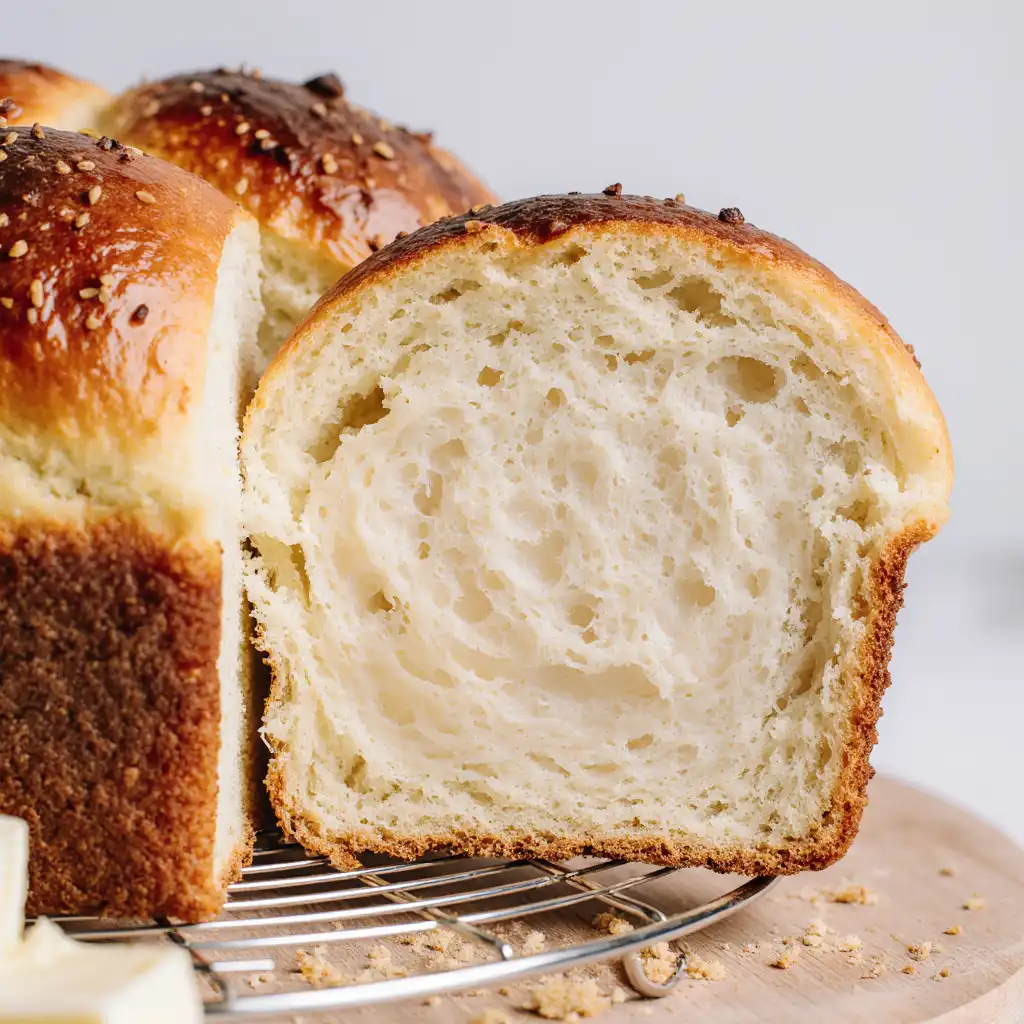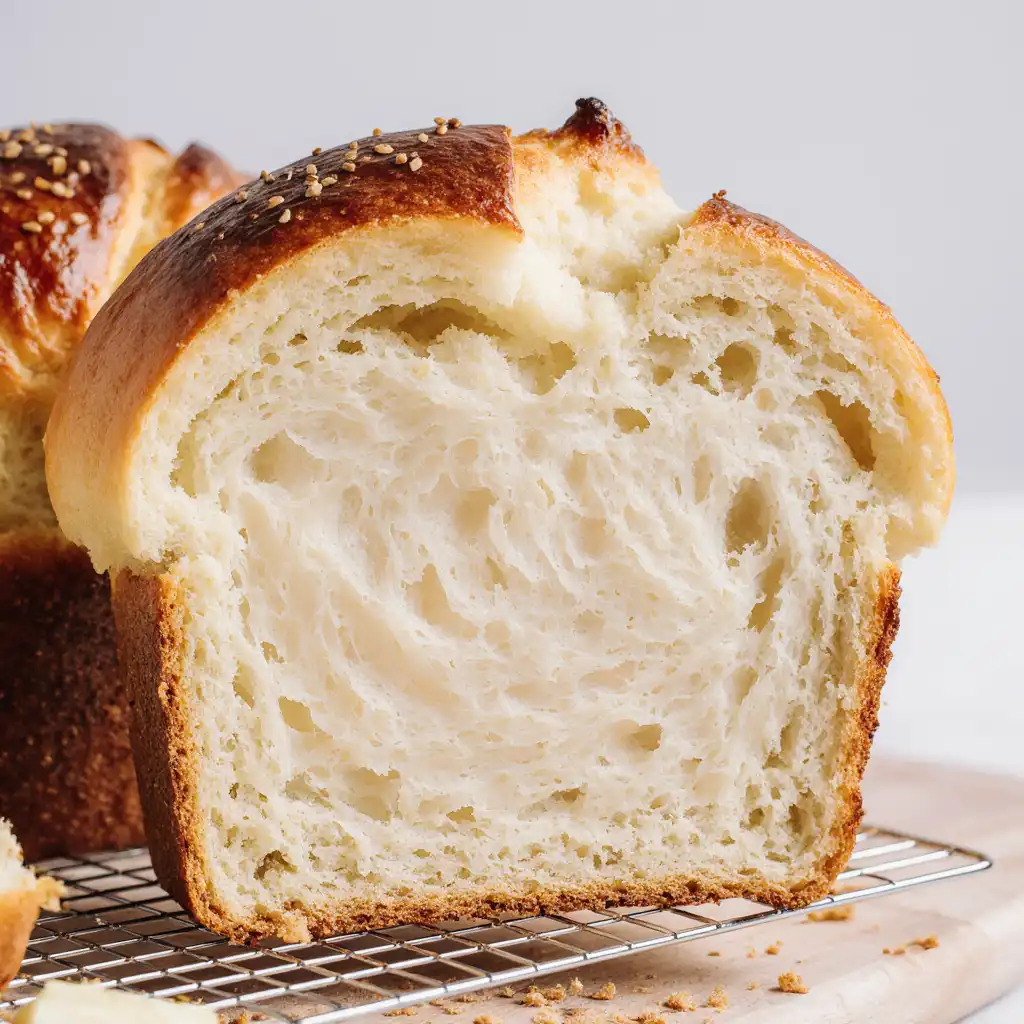Easy Homemade Brioche Recipe for Perfectly Soft Bread

Introduction
Have you ever wondered why some breads just melt in your mouth while others turn out dense and tough? Soft, buttery, and slightly sweet, the secret to bakery-quality bread lies in the dough—and with this easy homemade brioche recipe for perfectly soft bread, you can recreate that magic right in your kitchen. Many people shy away from making brioche because they imagine complicated steps or long waits. But with the right guidance and a little patience, making soft, pillowy brioche bread is easier than you think. This recipe demystifies the process and ensures you get a loaf that’s fluffy, rich, and delicious every time.
Ingredients List
To whip up this easy homemade brioche, you’ll need simple pantry staples along with a few key ingredients to achieve that indulgently soft texture:
– 3 ½ cups (440g) all-purpose flour (can substitute half with bread flour for extra chew)
– ¼ cup (50g) granulated sugar
– 2 teaspoons instant yeast
– 1 teaspoon salt
– 4 large eggs (room temperature)
– ½ cup (120ml) whole milk (or full-fat dairy alternative)
– 1 cup (225g) unsalted butter, softened
– 1 egg yolk + 1 tablespoon milk (for egg wash)
Substitutions and Dietary Alternatives:
– For a dairy-free version, swap milk with almond or oat milk and use vegan butter.
– Use coconut sugar or maple syrup instead of granulated sugar for a refined sugar-free option.
– Gluten-free flour blends can work, but expect a denser crumb.
Timing
– Prep time: 20 minutes
– First rise: 1 hour 30 minutes
– Second rise: 45 minutes
– Baking time: 30–35 minutes
– Total time: Approximately 3.5 hours (including rising)
While the clock might look intimidating, much of this time involves letting the dough rest, which is essential for that signature soft crumb and subtle sweetness. Imagine the dough as a living canvas—you’re simply allowing it to develop flavor and texture before baking it into a golden delight.
Step-by-Step Instructions
Step 1: Combining Dry Ingredients
In a large mixing bowl, whisk together the flour, sugar, instant yeast, and salt. It’s important to keep yeast and salt apart initially because salt can inhibit yeast activity if they come into contact too early.
Chef’s tip: Use instant yeast for a quick rise; active dry yeast requires proofing first.
Step 2: Adding Wet Ingredients
Create a well in the center of your dry ingredients and add the eggs and warm milk. Mix with a wooden spoon or your stand mixer on low speed until the dough begins to come together.
Step 3: Incorporate the Butter Gradually
Slowly add the softened butter piece by piece while mixing continuously. This may take 5–7 minutes. The dough will feel sticky but elastic.
Expert advice: Using eggs and butter at room temperature helps them incorporate better and ensures even mixing.
Step 4: Kneading the Dough
Knead the dough by hand on a lightly floured surface or use your stand mixer with a dough hook attachment for 8–10 minutes. You’re looking for a smooth, slightly tacky dough that springs back when pressed.
Step 5: First Rise
Place the dough in a clean, lightly greased bowl and cover with a damp cloth or plastic wrap. Let it rise in a warm spot until doubled in size, around 1 hour 30 minutes.
Step 6: Shaping
Punch down the dough gently to release air and then shape it into a loaf or divide into small rolls. Transfer to a greased or parchment-lined loaf pan or baking tray.
Step 7: Second Rise
Cover again and let the dough rise for another 45 minutes. Brush the top with the egg wash (egg yolk mixed with milk) to get a shiny, golden crust.
Step 8: Baking
Bake at 350°F (175°C) for 30–35 minutes or until the bread is deeply golden brown and sounds hollow when tapped at the bottom.
Step 9: Cooling
Remove the brioche from the oven and cool completely on a wire rack before slicing.
Enjoy the aroma filling your kitchen — your homemade brioche loaf is ready!

Nutritional Information
Here’s an approximate breakdown per 100g serving of brioche bread:
– Calories: 330 kcal
– Protein: 8g
– Carbohydrates: 45g
– Sugars: 7g
– Fat: 13g (mostly from butter)
– Saturated fat: 8g
– Fiber: 1.5g
– Sodium: 230mg
This rich bread delivers a moderate amount of protein and carbs, balanced with a decadent amount of butterfat, which makes it irresistible.
Healthier Alternatives
– Use whole wheat or spelt flour (replace up to 50%) for extra fiber and nutrients without sacrificing too much softness.
– Swap white sugar for honey or agave syrup to add natural sweetness along with minerals.
– Replace half the butter with olive oil or mashed avocado to reduce saturated fats while keeping moisture.
– Add seeds or nuts like flaxseeds or walnuts to boost omega-3 fatty acids and give a pleasant crunch.
Making simple swaps yields a more nutrient-dense version while preserving that perfect soft brioche texture.
Serving Suggestions
Brioche’s slightly sweet and buttery flavor pairs wonderfully with both sweet and savory accompaniments.
– Serve toasted with jam, honey, or Nutella for a decadent breakfast.
– Use as a base for French toast topped with seasonal berries or yogurt.
– Make gourmet sandwiches with turkey, brie, and cranberry sauce.
– Pair with rich dishes like coq au vin or beef stew—its soft crumb soaks up sauces beautifully.
– During holidays, slice and toast slices with melted foie gras or smoked salmon for an elegant appetizer.
Try seasonal twists like spreading pumpkin butter in autumn or fresh herb butter in summer to make the most of your homemade loaf.
Common Mistakes to Avoid
– Using cold ingredients: Butter and eggs should be room temperature to mix well and create proper dough consistency.
– Adding too much flour: Sticky dough is normal for brioche; avoid over-flouring or the bread will turn dense.
– Rushing proofs: Skipping adequate rising time means the bread won’t fluff up nicely.
– Oven temperature too low or high: Too low results in pale crusts; too high may burn the outside with an undercooked center.
– Not brushing egg wash: This step is crucial for that shiny, golden crust everyone loves.
By being mindful of these points, your brioche will come out bakery-quality every time.
Storing Tips
– Once cooled, wrap your brioche tightly in plastic wrap or store in an airtight container to preserve moisture.
– Keep it at room temperature for up to 3 days.
– For longer storage, freeze slices in ziplock bags for up to 3 months. Defrost at room temperature or toast directly from frozen for best texture.
– Avoid refrigerating as it tends to dry out enriched breads like brioche.
Proper storage means you can enjoy perfect soft bread days after baking.
Conclusion
Mastering perfectly soft brioche is achievable with just a handful of simple ingredients and a bit of patience. This easy homemade recipe takes you through each step intuitively, ensuring rich, fluffy results that rival your favorite bakery. Ready to elevate your bread game? Give this recipe a try and transform your kitchen into a brioche haven!
Don’t forget to share your baking success or questions in the comments below. Subscribe to our newsletter for more irresistible bread recipes and kitchen tips!
FAQs
Q1: Can I make brioche bread without a stand mixer?
Absolutely! You can knead the dough by hand on a lightly floured surface. It might take a bit more elbow grease, but the results will be just as delicious.
Q2: How do I know when the dough has risen enough?
A good rule of thumb is to let your dough double in size. To test, gently press your finger into the dough; if the indentation remains, it’s ready.
Q3: Can I add flavorings like vanilla or orange zest?
Definitely! Adding a teaspoon of vanilla extract or a tablespoon of fresh orange zest to the dough imparts delightful aromas without affecting the texture.
Q4: Why is my brioche dense and not soft?
This usually indicates insufficient kneading or rising time. Make sure to knead until elastic and allow proper proofing for the dough to develop airiness.
Q5: Can I turn brioche dough into rolls instead of a loaf?
Yes! Divide the dough into equal portions and shape them into balls. Place on a baking tray and follow the same rising and baking instructions.






